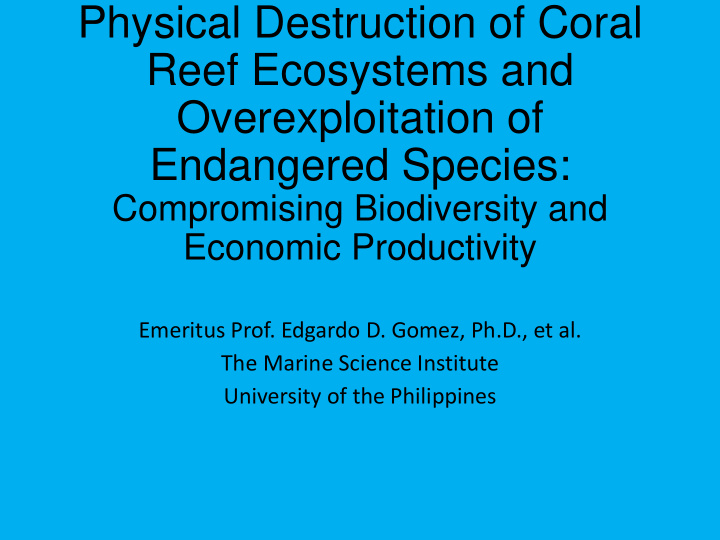



Physical Destruction of Coral Reef Ecosystems and Overexploitation of Endangered Species: Compromising Biodiversity and Economic Productivity Emeritus Prof. Edgardo D. Gomez, Ph.D., et al. The Marine Science Institute University of the Philippines
Coral reefs sustain fish life • Fusiliers & • Jacks among others • (Show Video 1)
Reclamation Activities GAVEN REEF (BURGOS REEF)
An aerial photo taken over the Gaven Reefs in the Spratly Islands in the South China Sea on Oct. 4 (Source: The Asahi Shimbun – Asia and Japan Watch)
Reclamation Activities FIERY CROSS REEF (KAGITINGAN REEF)
Details of plans published by the No. 9 Design & Research Institute of China State Shipbuilding Corporation showing a possible Chinese military base on reclaimed land in the Spratly islands. (China State Shipbuilding Corporation)
Recent estimates (March 2015) of reef ecosystems destroyed in the Spratlys: EST. RECLAIMED REEF LAND AREA • From images in Jane’s magazine: GAVEN REEF 14 has UNION REEF NORTH 7.5 has UNION REEF SOUTH 12.5 has CUATERON REEF 12 has FIERY CROSS REEF 265 has TOTAL RECLAIMED 311 has AREA
Coral Reef Ecosystem services value CORAL REEF Int.$/ha/yr 55 55,724 ,724 Provisioning services 677 Food $ 350,000 350,000 /ha/yr 21,528 Raw Materials 33,048 Genetic resources 472 Ornamental resources 171,47 17 1,478 Regulating services 1,188 Climate regulation 16,991 Disturbance moderation 85 Waste treatment 153,214 Erosion prevention 16 16,210 ,210 Habitat services Global estimates of the value of ecosystems 16,210 Genetic diversity and their services in monetary units (de Groot 108,83 10 8,837 et al., 2012) Cultural services 11,390 Esthetic information 96,302 Recreation 1,145 Cognitive information 35 352,24 2,249 Total economic
Economic value of coral reefs and what we are losing • Considering direct use, indirect use, existence values, etc. - de Groot (2012) @ $350,000/hectare/year • Applied to the area reclaimed to date ~ 311 hectares • Gives more than $ 100,000,000.00 lost to the countries around the South China Sea annually
Show Video 2
Biodiversity in Adversity: Wholesale removal of giant clam shells, dead or alive, by Chinese fishers The Return of the Giant Clam by Edgardo D. Gomez
Where all the giant clam shells go: Tanmen, Hainan, China
A few cultured Tridacna gigas , the true giant clam, in the Philippines (with a diver swimming above for scale)
Ecosystem services of giant clams at the Hundred Islands National Park, Philippines
Healthy coral reefs in the West Philippine Sea (=SCS) are important for the productivity of neighboring marginal seas, such as thru larval connectivity (Kool 2011)
Thank you for your attention. Acknowledgement: This presentation represents a combination of information from various sources: marine scientific research in the Philippines and other countries, led by many individuals, government agencies, and open sources
Recommend
More recommend